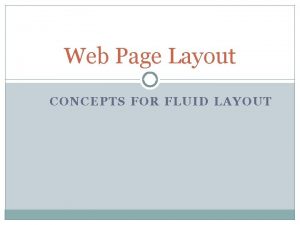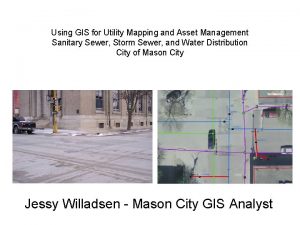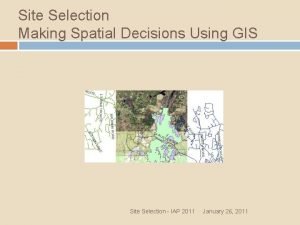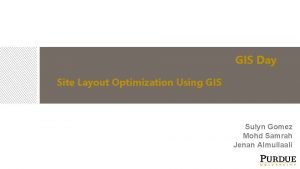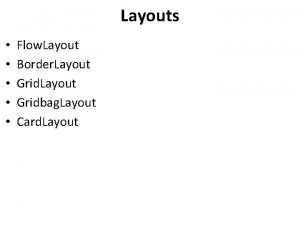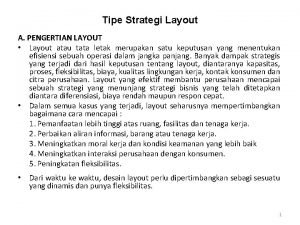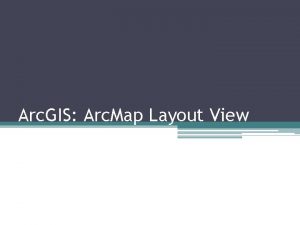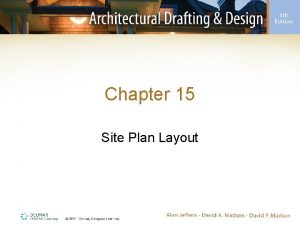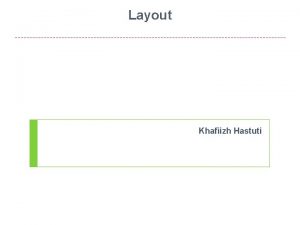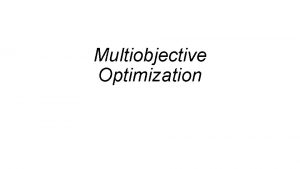GIS Day Site Layout Optimization Using GIS Sulyn


















- Slides: 18

GIS Day Site Layout Optimization Using GIS Sulyn Gomez Mohd Samrah Jenan Almullaali

What should be considered in a site layout? 1. Safety - Site accessibility 2. Information signs 3. Security 4. Accommodation 5. Offices 6. Water supply & sanitation 7. Material handling 8. Storage & site cleaning 9. Batch plant & fabrication shops (if required) 10. Transport routes, walkways etc

Site Layout Planning Safety and Health Materials Equipment Space Construction Schedule Safety Improvement Saving Travel Time & Cost Site space is considered a limited resource in construction projects Productivity Improvement Space Utilization Improvement

Site Layout Planning

Site Selection with GIS Establish criterion Site space is considered a limited resource in construction projects Slop conditions (Flat? ) Near some specific buildings or other TF Far from specific TF TF Layout: Minimize cost Without compromising safety

Site Selection with GIS Different analysis can be made based on users’ needs Slope • Use GIS (overlay analysis) to combine the characteristics of several datasets into one. • Find specific locations or areas that have a certain set of attribute values - match the criteria you want: Suitable locations. Distance to specific points

Site Selection with GIS Proximity Analysis Basic questions in GIS is "what's near what? " • How close is my job site to a warehouse? • What is the distance between two locations? • What is the nearest or farthest distance to some points? • What is the shortest street network route from some location to another

Site Selection with GIS Performance Weekly Performance Weeks Travel Time: 25 -40%

Site Selection with GIS – Case Study

Site Selection with GIS

Site Selection with GIS – Case Study Decision Variables • Spatial location • Number of TF • Type of equipment Optimization • Objective function: • Minimize cost (Travel time) and maximize productivity

Site Selection with GIS

Site Selection with GIS Cost distance take into account that distance can also be measured in cost, and that travel cost can vary with terrain, ground cover, or other factors. Proximity Relationships - buffer features: Service area

GIS for placing Tower Cranes Poor decisions Negative effects • Additional Costs • Delays Many mathematical models have been developed over the past 20 years for solving tower crane problems Limited attempts based on a graphical

GIS for placing Tower Cranes Input data: Spatial Data (GIS) • Shape, position and spatial characteristics of the loads and obstacles • Geometric layout of loads Process: Optimal number of tower cranes • Location • Mainly focus on outdoor environment • Geospatial data is georeferenced, objects are defined in a physical world • GIS can perform different spatial operations GIS Output: Wide range of spatial data • Develop a crane location model • i. e. Lowest possibility of conflict: Set a crane conflict criteria (Others can be in terms of cost or time) • Monitor cranes movement to prevent collision + Visualization techniques -> Integration with BIM

-Maximum load -Type of available tower cranes Group tasks into separated classes based on closeness relationship Minimum number of tower cranes 4 Generate feasible areas for locating the tower cranes 3 Determine: Geometric layout of supply and demand points 2 1 GIS for placing Tower Cranes Optimize location of tower cranes based on its service area and its load chart that specifies lifting capacity

Closing

Thank you
 Day 1 day 2 day 3 day 4
Day 1 day 2 day 3 day 4 Day 1 day 2 day 817
Day 1 day 2 day 817 Hot site cold site warm site disaster recovery
Hot site cold site warm site disaster recovery Numerator layout
Numerator layout Language
Language Cddat
Cddat Liquid layout website
Liquid layout website Utility mapping using gis
Utility mapping using gis Making spatial decisions using gis
Making spatial decisions using gis Facilities location planning
Facilities location planning Schoolmax gradebook
Schoolmax gradebook Ocean the part day after day
Ocean the part day after day Day to day maintenance
Day to day maintenance As your room gets messier day by day, entropy is
As your room gets messier day by day, entropy is I don't know tomorrow
I don't know tomorrow Romeo and juliet summary
Romeo and juliet summary Growing day by day
Growing day by day Define seed dormancy
Define seed dormancy Day by day seed germination observation chart
Day by day seed germination observation chart






